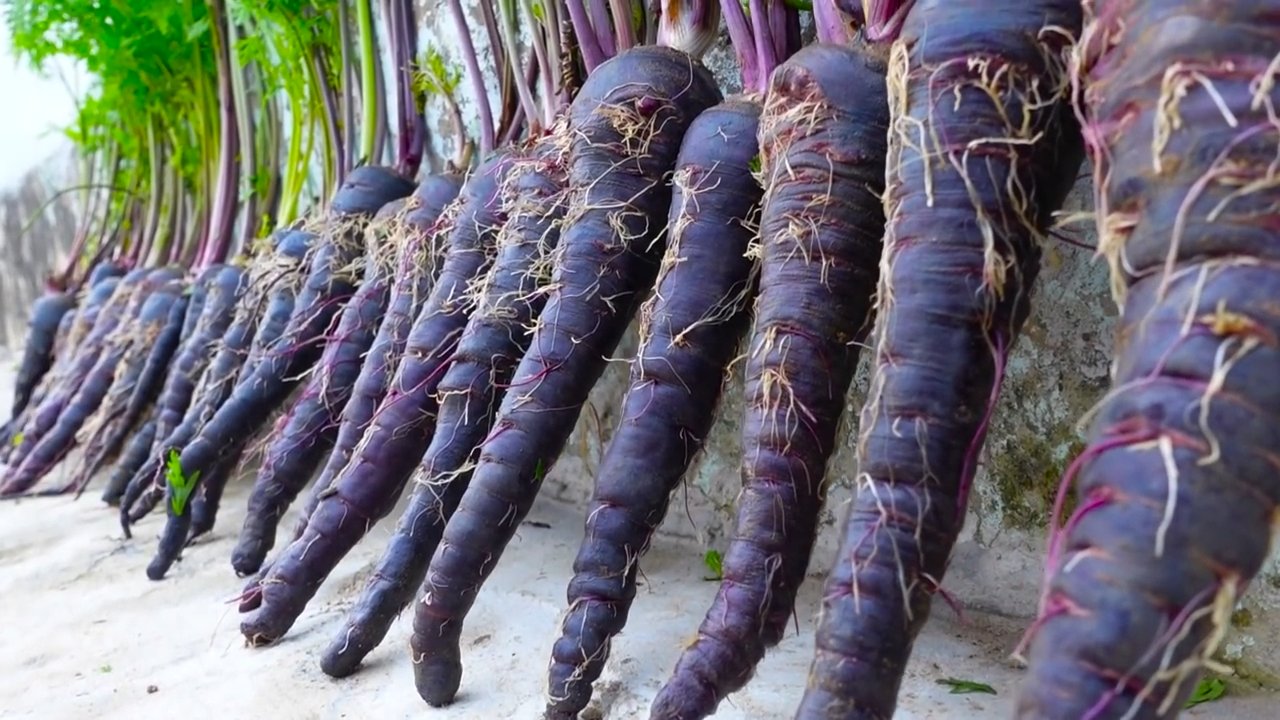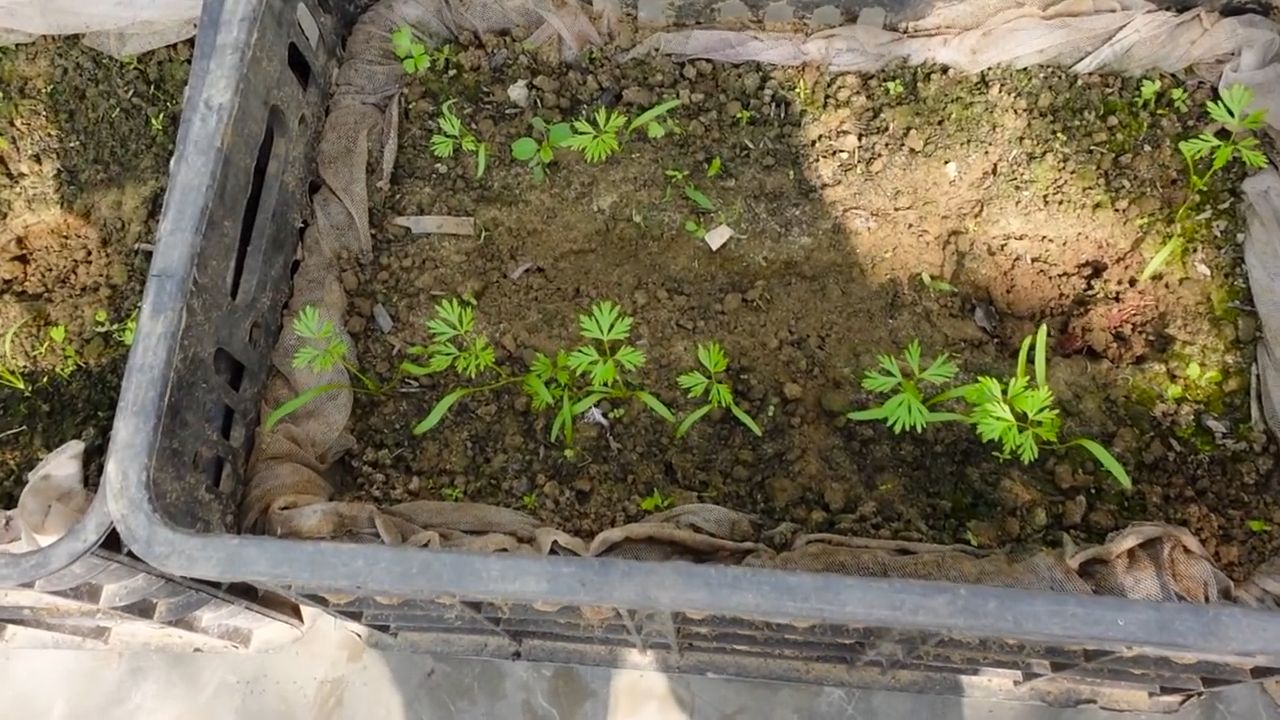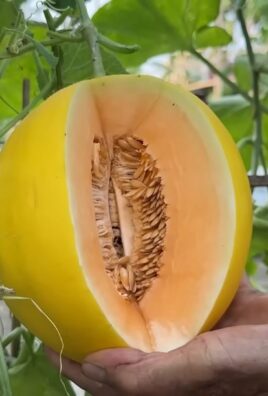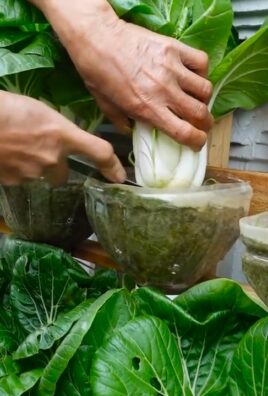Grow Purple Carrots Easily and unlock a vibrant splash of color in your garden and on your plate! Have you ever dreamt of pulling a carrot from the earth, not orange, but a deep, regal purple? It sounds like something out of a fairytale, right? Well, it’s not only possible, but surprisingly simple with a few clever tricks and DIY techniques.
Purple carrots aren’t just a modern novelty; their history stretches back centuries! Originating in the Middle East and Asia, these colorful root vegetables were actually the dominant carrot variety before the 17th century. Orange carrots, believe it or not, are a relatively recent development! So, by learning to grow purple carrots easily, you’re connecting with a rich agricultural heritage.
But why bother with purple carrots? Beyond their stunning visual appeal, they’re packed with anthocyanins, powerful antioxidants that offer a range of health benefits. Plus, growing your own produce is incredibly rewarding! Imagine the satisfaction of serving a vibrant, homegrown salad featuring these unique carrots. In this article, I’m going to share my favorite DIY tricks and hacks to help you cultivate a thriving crop of purple carrots, even if you’re a beginner gardener. Get ready to add a touch of magic and a whole lot of nutrition to your garden!

Growing Purple Carrots Yourself: A Beginner-Friendly Guide
Hey garden friends! Do you want to add a colorful touch to your vegetable patch? Then you’ve come to the right place! I’ll show you how you can easily grow purple carrots yourself. Don’t worry, it’s really no harder than growing orange carrots. Let’s get started!
Why Purple Carrots?
Before we get into the details, here’s a quick rundown of why I’m so enthusiastic about purple carrots:
- Color: They are simply beautiful! The intense color makes any dish an eye-catcher.
- Health: Purple carrots are rich in anthocyanins, powerful antioxidants that can have anti-inflammatory effects and strengthen the immune system.
- Taste: They taste slightly sweet and have a mildly spicy note.
- Variety: They simply bring variety to the menu and are a great way to get kids excited about vegetables.
What You Need for Cultivation
Here is a list of everything you’ll need to grow purple carrots:
- Carrot seeds (purple variety): Make sure to buy high-quality seeds of a purple carrot variety. There are several types, such as ‘Purple Haze’, ‘Purple Dragon’, or ‘Deep Purple’.
- Gardening tools: Spade, rake, possibly a small trowel or planting scoop.
- Good soil: Carrots prefer loose, sandy soil. Heavy, loamy soils should be improved with sand and compost.
- Compost or organic fertilizer: For a good supply of nutrients.
- Watering can or garden hose: for regular watering.
- Optional marking stakes and string: To create straight rows.
- Patience: Carrots need some time to grow.
Step-by-Step Guide to Growing Purple Carrots
Alright, let’s get down to it! Here is a detailed guide on how to grow your own purple carrots:
1. Preparing the Soil
- Location Selection: Choose a sunny spot for your carrots. They need at least 6 hours of sun per day.
- Loosen the Soil: Thoroughly loosen the soil with a spade or a digging fork. Remove stones, roots, and other obstacles. Carrots like it when the soil is nice and loose so they can develop well.
- Improve the Soil: Mix compost or organic fertilizer into the soil. This improves the nutrient supply and soil structure. For heavy soils, you should also mix in sand to improve drainage.
- Create a Level Surface: Rake the area smooth to create a level surface for sowing.
2. Sowing the Carrot Seeds
- Create Rows: Use a rake or a stick to draw straight rows in the soil. The rows should be about 20-30 cm apart.
- Sowing Depth: The sowing depth should be about 1-2 cm. Carrots are light-dependent germinators, so the seeds must not be too deep in the soil.
- Sow the Seeds: Distribute the carrot seeds evenly in the rows. Since carrot seeds are very small, it’s often difficult to sow them individually. You can mix them with some sand to help distribute them better.
- Cover the Seeds: Carefully cover the seeds with a thin layer of soil.
- Water In: Water the rows carefully with a watering can or a garden hose. Be careful not to wash the soil away.
3. Caring for the Carrot Plants
- Watering: Keep the soil evenly moist, especially during germination and in dry periods. Avoid waterlogging, as this can lead to root rot.
- Weeding: Regularly remove weeds, as they rob the carrots of nutrients and light. Be careful not to damage the delicate carrot roots in the process.
- Thinning: When the carrot seedlings are about 5 cm tall, you should thin them out. This means removing the weakest plants so that the remaining plants have enough space to grow. The distance between the plants should be about 3-5 cm.
- Fertilizing: Fertilize the carrot plants about every 4-6 weeks with an organic fertilizer. Make sure the fertilizer is not too high in nitrogen, as this can lead to too much leaf growth and little root growth.
- Pest Protection: Carrots can be infested by various pests, such as the carrot fly. To protect your carrots, you can stretch an insect net over the bed.
4. Harvesting the Purple Carrots
- Harvest Time: The harvest time depends on the variety and growing conditions. As a rule, carrots are ready for harvest after about 70-80 days.
- Harvesting: Carefully pull the carrots out of the ground. If the soil is very firm, you can use a digging fork for assistance.
- Cleaning: Remove the soil from the carrots and cut off the green tops.
- Storage: Store the carrots in a cool, dark, and dry place. They will keep in the refrigerator for about 2-3 weeks.
Additional Tips for Successful Cultivation
Here are a few more tips that can help you successfully grow purple carrots:
- Observe Crop Rotation: Do not grow carrots in the same spot every year. Crop rotation helps to prevent diseases and pests.
- Companion Planting: Carrots benefit from companion planting with other plants, such as onions, garlic, or marigolds. These plants can repel pests.
- Soil Analysis: If you are unsure what nutrients your soil needs, you can have a soil analysis done.
- Be Patient: Carrots take time to grow. Be patient and don’t give up if it doesn’t work out right away.
Common Problems and Solutions
Problems can also arise when growing purple carrots. Here are some common problems and solutions:
- Poor Germination: Causes can be poor seed quality, sowing too deep, or soil that is too dry or too wet. Solution: Use fresh seeds, pay attention to the correct sowing depth, and water regularly.
- Crooked Carrots: Causes can be stones or compacted soil. Solution: Loosen the soil thoroughly and remove stones.
- Carrot Fly: The larvae of the carrot fly feed on the carrot roots. Solution: Use an insect net, and practice companion planting with onions or garlic.
- Root Rot: Causes can be waterlogging or fungal infestation. Solution: Ensure good drainage, avoid waterlogging, and use a fungicide if necessary.
Recipes with Purple Carrots
Now that you have harvested your own purple carrots, you can of course use them in the kitchen. Here are a few ideas:
Carrot Cake: Try a carrot cake with purple carrots!
Raw: Purple carrots taste great raw, e.g., as a snack or in a salad.
Cooked: You can boil, steam, fry, or grill them.
Soups and Stews: They give soups and stews a beautiful color and a special taste.

Conclusion
So, there you have it! Growing purple carrots isn’t just a whimsical gardening project; it’s a gateway to unlocking a more vibrant, nutritious, and visually stunning culinary experience. We’ve explored the simple steps to transform your garden (or even a container on your balcony!) into a haven for these antioxidant-rich beauties. From selecting the right seeds to nurturing your seedlings and harvesting your colorful crop, you’re now equipped with the knowledge to embark on this rewarding journey.
But why is this DIY trick a must-try? Beyond the sheer novelty of pulling a vividly purple carrot from the earth, you’re investing in your health. Purple carrots boast significantly higher levels of anthocyanins compared to their orange counterparts. These powerful antioxidants combat free radicals, potentially reducing the risk of chronic diseases and promoting overall well-being. Plus, let’s be honest, a plate featuring these vibrant vegetables is simply more appealing!
Don’t be afraid to experiment! Consider these variations to personalize your purple carrot growing adventure:
* Companion Planting: Plant your purple carrots alongside rosemary or sage to deter carrot root flies. Marigolds are also excellent companions, attracting beneficial insects and adding a splash of color to your garden.
* Container Gardening: If you’re short on space, purple carrots thrive in containers. Choose a pot that’s at least 12 inches deep and wide to accommodate their root growth. Ensure proper drainage to prevent waterlogging.
* Heirloom Varieties: Explore different heirloom varieties of purple carrots, such as ‘Purple Dragon’ or ‘Cosmic Purple,’ each offering unique flavor profiles and shades of purple.
* Roasting with Herbs: Once harvested, roast your purple carrots with a drizzle of olive oil, a sprinkle of sea salt, and your favorite herbs like thyme or rosemary for a simple yet elegant side dish.
* Juicing and Smoothies: Incorporate raw purple carrots into your juices and smoothies for a nutritional boost and a beautiful purple hue.
Growing purple carrots is more than just a gardening project; it’s an investment in your health, a celebration of color, and a testament to the wonders of nature. It’s a chance to connect with the earth, nurture life, and reap the rewards of your labor.
We wholeheartedly encourage you to try this DIY trick and experience the joy of growing your own purple carrots. Whether you’re a seasoned gardener or a complete beginner, the process is surprisingly straightforward and incredibly rewarding.
Once you’ve harvested your first batch of vibrant purple carrots, we’d love to hear about your experience! Share your photos, tips, and recipes in the comments below. Let’s create a community of purple carrot enthusiasts and inspire others to embrace the beauty and benefits of these remarkable vegetables. Happy gardening!
Frequently Asked Questions (FAQ)
What are the benefits of growing purple carrots compared to orange carrots?
Purple carrots are packed with anthocyanins, powerful antioxidants that give them their vibrant color. These antioxidants are linked to various health benefits, including reducing the risk of heart disease, improving cognitive function, and protecting against certain types of cancer. While orange carrots are rich in beta-carotene, purple carrots offer a unique nutritional profile that complements a healthy diet. Furthermore, growing purple carrots adds visual appeal to your garden and your plate, making mealtimes more exciting.
What type of soil is best for growing purple carrots?
Purple carrots, like all carrots, prefer loose, well-drained soil that is free of rocks and debris. Rocky soil can cause the roots to split or become misshapen. Amend heavy clay soil with compost or other organic matter to improve drainage and aeration. The ideal soil pH for carrots is between 6.0 and 6.8. Before planting, consider conducting a soil test to determine its pH and nutrient levels.
How often should I water my purple carrots?
Consistent moisture is crucial for healthy carrot growth. Water deeply and regularly, especially during dry periods. Aim to keep the soil consistently moist but not waterlogged. Overwatering can lead to root rot, while underwatering can cause the carrots to become stunted and tough. A good rule of thumb is to water when the top inch of soil feels dry to the touch. Mulching around the plants can help retain moisture and suppress weeds.
When is the best time to plant purple carrots?
The best time to plant purple carrots depends on your climate. In general, carrots are a cool-season crop and thrive in temperatures between 60°F and 70°F. In areas with mild winters, you can plant carrots in the fall for a winter or early spring harvest. In colder climates, plant carrots in the spring as soon as the soil can be worked. You can also succession plant carrots every few weeks to ensure a continuous harvest throughout the growing season.
How long does it take for purple carrots to mature?
Purple carrots typically take between 70 and 80 days to mature, depending on the variety and growing conditions. You can harvest them when they reach the desired size, usually around 6-8 inches long. To check for maturity, gently loosen the soil around the base of the plant and pull up a carrot to inspect its size and color.
What are some common pests and diseases that affect purple carrots, and how can I prevent them?
Common pests that affect purple carrots include carrot root flies, aphids, and nematodes. Carrot root flies lay their eggs near the base of the plants, and the larvae burrow into the roots, causing damage. To prevent carrot root fly infestations, use row covers to protect your plants, practice crop rotation, and avoid planting carrots in the same location year after year. Aphids can be controlled with insecticidal soap or neem oil. Nematodes can be a more challenging problem, but soil solarization and the use of resistant varieties can help. Diseases that can affect purple carrots include leaf blight and root rot. Ensure good air circulation around the plants to prevent leaf blight, and avoid overwatering to prevent root rot.
Can I grow purple carrots in containers?
Yes, purple carrots can be successfully grown in containers. Choose a container that is at least 12 inches deep and wide to accommodate the root growth. Use a well-draining potting mix and ensure that the container has drainage holes. Water regularly and fertilize with a balanced fertilizer every few weeks. Container-grown carrots may require more frequent watering than those grown in the ground.
How do I store purple carrots after harvesting?
To store purple carrots after harvesting, remove the tops and gently brush off any excess soil. Store them in a cool, dark, and humid place, such as the refrigerator crisper drawer. You can also store them in a root cellar or a cool basement. Place the carrots in a plastic bag or container to prevent them from drying out. Properly stored purple carrots can last for several weeks or even months.
Are there different varieties of purple carrots?
Yes, there are several varieties of purple carrots available, each with its own unique characteristics. Some popular varieties include ‘Purple Dragon,’ ‘Cosmic Purple,’ and ‘Deep Purple.’ ‘Purple Dragon’ is known for its sweet flavor and vibrant purple color, while ‘Cosmic Purple’ has a purple exterior and an orange interior. ‘Deep Purple’ is a uniformly purple carrot with a slightly spicy flavor. Experiment with different varieties to find your favorite.
Can I save seeds from my purple carrots?
Yes, you can save seeds from your purple carrots, but it’s important to note that carrots are biennials, meaning they require two growing seasons to produce seeds. In the first year, the plant will produce roots and foliage. In the second year, it will flower and produce seeds. To save seeds, select healthy, disease-free plants and allow them to overwinter in the ground. In the spring, the plants will bolt and produce flowers. Allow the flowers to dry on the plant, then harvest the seeds and store them in a cool, dry place. Be aware that cross-pollination can occur with other carrot varieties, so the seeds may not produce true-to-type carrots.




Leave a Comment